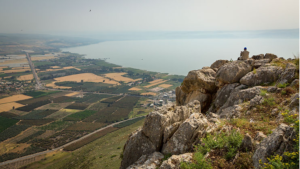The Sea of Galilee is a beautiful freshwater lake that often reflects the golden rays of the early morning sun darting across its calm colorful waters. Lying 690 feet below sea level, this large body of water stands at center stage within a coliseum of hills once belonging to the Israelite tribes of Naphtali, Gad, and Manasseh. Nestled between the rolling hills and dramatic scarps of Lower Galilee on the west, and the hills of Bashan on the east, it has some 30 miles of shoreline which are shaped much like a musical lyre.
Considered by some to be the most famous lake in the world, its waters are derived from not only the runoff of rainfall in the area, but also from the refresh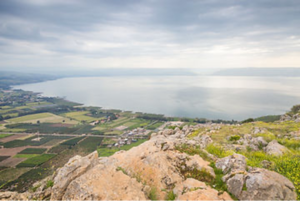 ing waters of
ing waters of
the Jordan River to the North, and from several springs found around and under the lake. Referred to only four times in the Old Testament, it was known then as the “Sea of Chinnereth” but in the New Testament as either Gennesaret, the Sea of Galilee, “Sea of Tiberias,” or some 31 times simply as “the Sea.”
The western side of this 13 by 7 ½ mile lake is located on a branch of the International Highway with cities like Magdala, Chinnereth, Capernaum, and Bethsaida lining its path. While each of these cities were important places in the ministry of Jesus, Capernaum was especially important because, according to Matthew 4:13, this was the place where Jesus made his home during his public ministry. It was also the administrative center of the region and was an important trade city along the international North/South Trade
Route. To this day the remains of many different millstones and public buildings can be found here; a testimony to the commerce and trade practiced at this busy location during New Testament times. The many mill stones discovered there remind us of how Jesus used his surroundings and cultural practices of his time to teach us about our relationship to others and the seriousness of sin (cf. Luke 17:1-2).
Somewhere by this 64 square mile lake, and just outside the city of Capernaum, Jesus healed a man of the horrible disease of leprosy (Matt. 8:1-4). It was also in the vicinity of this lakeside town that Jesus by the mere power of his word healed the centurion’s servant, by saying to him, “as you have believed, so be it done unto you.” It was within the city itself that Jesus healed Peter’s mother-in-law of a fever (Matthew 8:14-15), and where today Peter’s home is alleged to have been discovered.
At Capernaum Jesus performed many, many miracles and on one occasion worked well into the evening hours healing all kinds of infirmities and those who were possessed with demons (Mark 1:32-34). It was also here that four men carried a paralytic on a stretcher, lowering him down to Jesus who was teaching inside one of the local Jewish homes.
As one makes his or her way through the ancient homes of Capernaum the remains of an ancient synagogue of the Jews is easily in view. Though not the ruins of the actual synagogue visited by Jesus, it is nevertheless a synagogue built on top of the actual foundation that was in existence during the time of Christ.
The present synagogue, built sometime around the 4th century A.D. is of great importance because it gives us an excellent idea of the design and layout of an ancient house of worship utilized by the Jews. Similar in design to the synagogue built at Chorazin just a few miles to the north, the synagogue at Capernaum is different with imported white limestone used in its construction, and elaborate artwork inscribed on its columns and remains.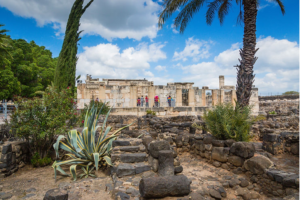
Imagine Jesus then coming to a place very similar to this (the synagogue) and healing a man’s hand that had withered or casting out the demon of a man who had been tormented by the power of Satan (Mark 3:3). It was here in this synagogue, and in this town and near this great body of water that Jesus both taught others about God and revealed the power he had to heal and forgive. Oh, the joy that must have been felt by those so afflicted by life’s sorrows.
But, not only did Jesus perform miracles near the Sea of Galilee, he also demonstrated His power on the sea. Because of the geographic features inherit in the land, sailing across the sea could at times be dangerous. The Sea of Galilee is in a geographic depression surrounded by hills, with the surface of the water resting at some690 feet below sea level. To the North, rising to heights of 9,230 feet above sea level lay the great Mount Hermon whose winds at times descend from its peak and were forced down into the tunnel-like trough of the Jordan Rift Valley. Sometimes the winds would come bursting out upon the water’s surface and capture by surprise a helpless small boat which could easily find itself imperiled.
Fishing vessels used on this lake during the first century were most likely no longer than the 27 foot long, 7 ½ foot wide ancient fishing vessel discovered in 1986 in the mud of the northwestern shoreline just south of Capernaum. The boat was estimated to be as old as the New Testament itself and is now on permanent display at the Yigal Allon Museum in Ginnosar.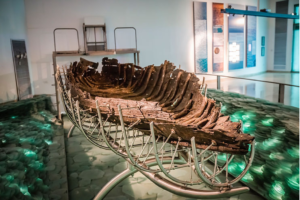
It has been dubbed as the “Jesus boat” because it was determined to be in use during the first century A.D., and thought to be employed as commercial fishing vessel. Just imagine how the disciples must have felt in such a small boat, struggling to maneuver through the crashing waves, petrified as they watched their boat fill with water and felt themselves beginning to sink into the darkness of the storm. In their desperation they questioned the Lord’s care and concern for them asking, “Master do you not care that we are perishing?” 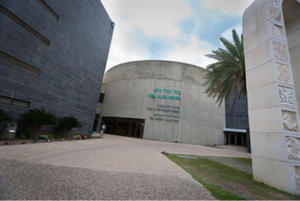
It was, however, in the midst of that furious storm, that the disciples like never before began to see Jesus as more than just some great teacher. With only a few words, “peace, be still”, Jesus caused the winds to cease and the waves to stop. “Even the winds and the seas obeyed Him,” they said. On that day, though their own faith had been lacking, they came to realize more fully the awesome power of Jesus and that He was a man like no other (Matt. 8:27).
Not only was the power of the Lord manifested in calming the storm, it was also seen in the miracle of the fish recorded in Luke 5:1-11. The context reveals that Peter and John and their cousins were seasoned fisherman who had labored through the night without catching a single fish. On the next morning when they had made their way back to the shore the Lord commanded them to launch out into the deep for a catch. Though hesitant at first, these beleaguered men let down their nets at the Lords command and hauled in a harvest of so many fish that their boats began to sink. It was obvious that these men loved Jesus and trusted him. They had seen the power of his miracles, so they launched out into the deep, they launched out in faith and as a result they were greatly rewarded.
Somewhere near to where the miracle of the catch took place, Jesus called his disciples to follow him. He said “Come and I’ll make you fishers of men.” When He did, they immediately left tending their nets and followed Him. From that moment on they committed their lives to something greater. Their overall purpose and goal in life became different. They forsook all and followed him. Doing so took faith. Faith that had been developed by being with Jesus and seeing his great power and hearing his great words of hope.
At the Sea of Galilee Jesus called this small band of men to leave their livelihoods and begin a new work of fishing for men. By his tremendous power and benevolent teaching, Jesus enabled multitudes of souls to see the greatness of his character and the nature of His existence. Both near and on the Sea of Galilee Jesus demonstrated his power not just over the winds and the waves, but also over the lives of men.
